
THE SELF-EXPONENTIATED FRACTAL
Each point z gives rise to an object, or a set
of complex points {Zn} arising from the iteration
process
Zn+1 := zZn,
Z0 = z.
In analogy to what is done to obtain the Mandelbrot set and many other fractals here we can only be interested the divergence or non-divergence of the iteration.
We chose to study the limit cycle period k, defined as the number of points in the limit cycle, for instance 1 if the iteration converges to one point, 2 if in the limit of large n the iteration jumps between two points, etc. Value k=0 means divergence (e.g. ...101010 obviously diverges).
[In numerical work, some value, e.g., k=-10 in my double precision Fortran code, needs to be reserved to numerically unresolved cases where k is too large to be established (40 in my program). In retrospect, a large positive value would have been better.]
Let us first consider the real axis of the complex plane. I've said that for large positive numbers we expect divergence. But the situation is different for large negative numbers. For instance, ...(-10)^(-10)^(-10) converges to a limit cycle of k=3 points, very close [to within ~10^(-10)] to -10, 0, and 1. The full survey of the real axis looks as follows

There are well known results showing that k=1 for e^(-e) < Re(z) < e^(1/e) . Numerically, that's 0.0659880 < x < 1.4446678. (At least these results are known to the students of my friend Waldek Paluba from Warsaw University. It's a nice exercise to rederive them, and to understand why Re(z)=1 is not a point where divergence starts). Also, the switch to k=2 at Re(z) < e^(-e) follows from this analysis. The negative axis, however, presents a complicated (fractal) situation. The result which will be amplified on a complex plane is that the k=2 region is very small compared with the dominant k=3 region.
The analogous cut along the imaginary axis of the complex plane shows a somewhat smoother picture, symmetrical with respect to the real axis. We see that the origin of the plane is surrounded by a small k=2 region.
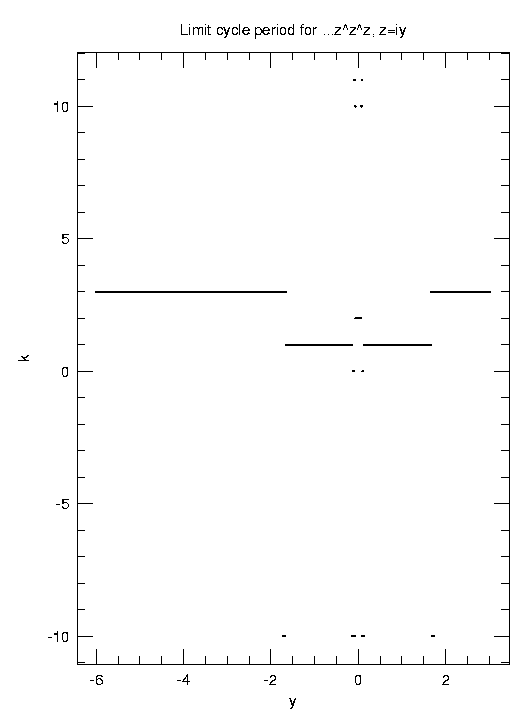
The figure below shows the results of the low-resolution
Complex World Survey. The vertical coordinate is the Re(z) contained
in the range (-5,5), and the horizontal coordinate is the Im(z)
contained in the same range. Color coding is the following:
black: k=3
dark grey: k>3
lighter grey (`binoculars'): k=1
almost white: k=2
white: k=0
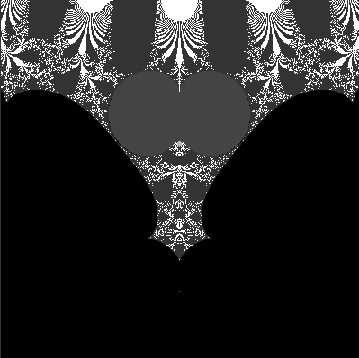
Complex exponentiation is a contraction and yields a single object (in accord with Banach contraction principle) in the area shaded light grey, which looks like binoculars. At present resolution, and maybe in reality, that part of the complex plane is a contiguous area. (See also the fig. below).
The vertical axis of the figure is the real axis, and can be compared to the figure k(x) above.
At k=3 and higher cycle period, the corresponding set in the z plane is clearly fragmented in a fractal manner.
In particular, the areas where the period is too long to be established by my program seem fractal. The high-k regions tightly surround the stable k=1 basin.
And, finally, it is a joy to look at the areas of divergence of complex exponentiation (white).
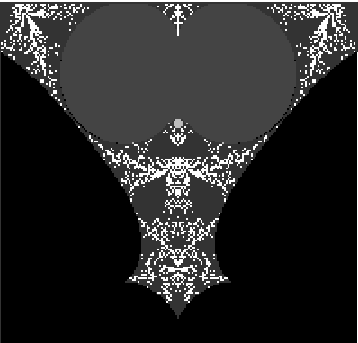
A closer look at the figure holding outstretched arms shows it is A SORCERER or SORCERESS, resembling the Egyptian animal gods (but then why is there a cross hanging over her?).
The sorceress has a small ball of period-two region on her head.
A detailed look at the region near the k=2 ball is is taken here .
At a higher resolution, however, the sorcerer(ess) all but disappears and the picture resembles that of her fortress surrounded by lush palm trees and flowers:
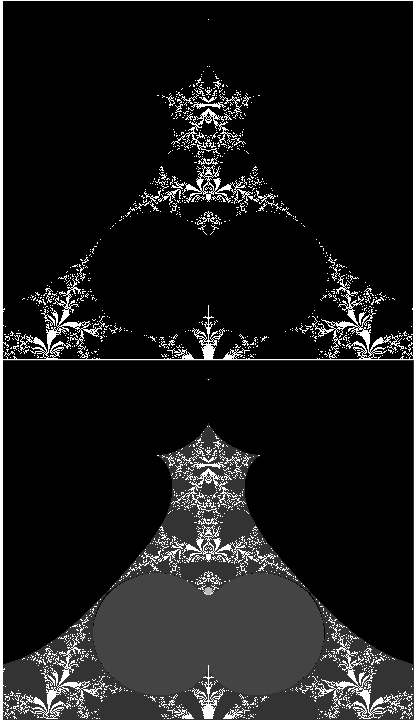
This is a "self-exponentiated" fractal, a cousin of a "self-squared" Mandelbrot set. The pictures show the period k of the limit cycle (0 = divergence).
The horizontal axis is Im(z) and extends from -3.5 to 3.5 over 800 pixels.
The vertical axis is Re(z) and extends from -4.5 (up) to 2.5 (down) over 700 pixels.
The upper panel:
white: k=0
black: other k
The lower panel:
white: k=0 (or >40)
black: k=3
grey: other k
A more global view of the fractal, whith Im(z) extending from -10 to 10 along the horizontal axis, and Re(z) from -5 to 15 on the vertical one, can be viewed here . Black denoted divergence of iteration (k=0). The palm trees (trunks of black alternating with k=4) have fractal canopy. Alternatively, one can view the convergence regions (k > 0) as a canopy. Then each level of the hierarchy of leaves has a cycle number larger by one than the parent set of leaves (fractal leaf sprouting)
A peculiar "trangular island" filled with diverging (k=0)
and very high-periodicity regions (k> 20) is found above the palace
(at z=-4.1). It shows up as barely one white pixel on the symmetry
axis in the hi-res survey above.
In fact, it's much much more...
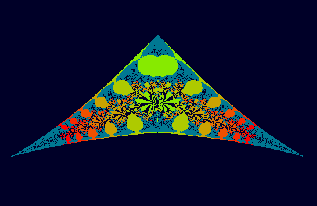
It is studied here.
Back to the home
page of Pawel Artymowicz
Back to the Astro-Mathematical
puzzle
Back to the solution
to
Part 2 of the puzzle
Last revised Feb 24, 1997